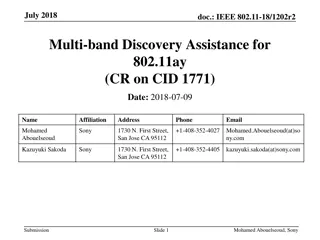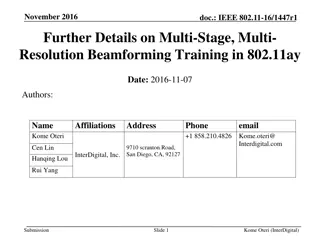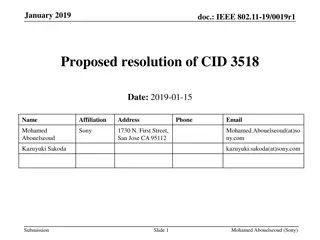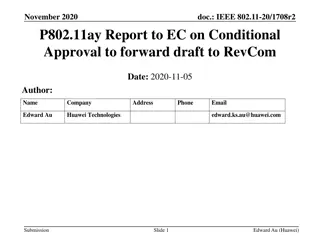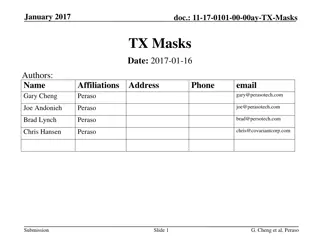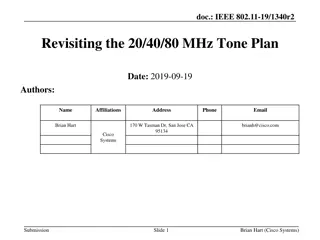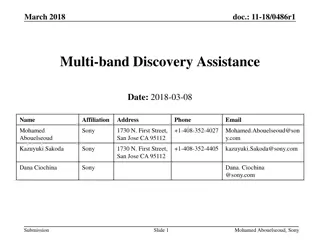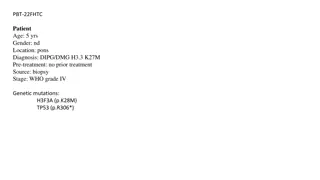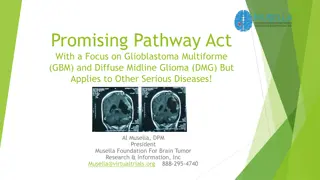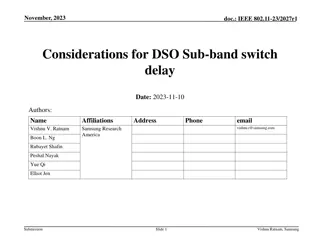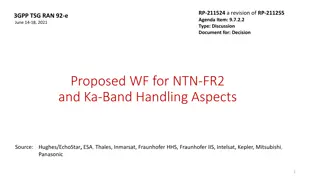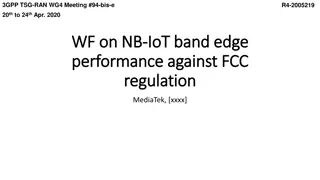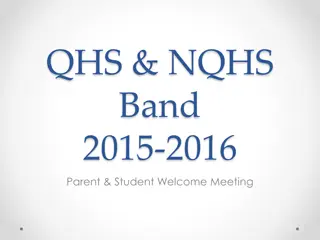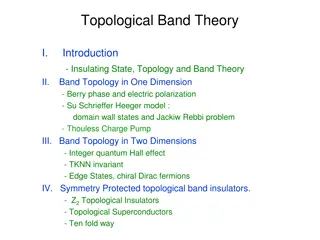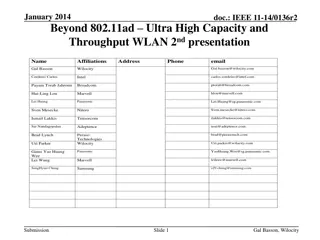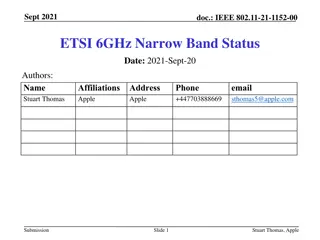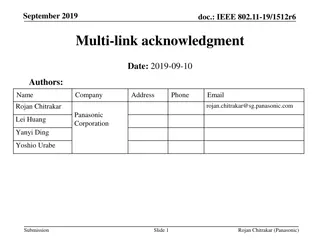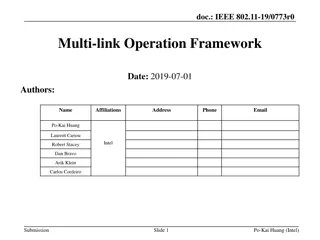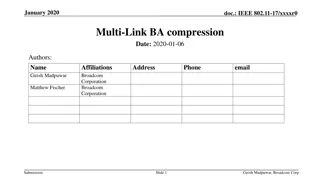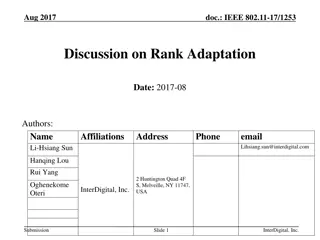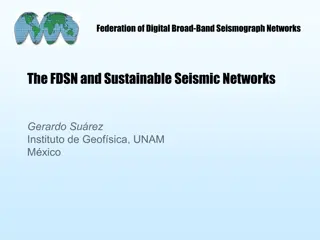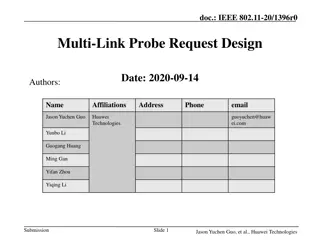Revisiting DMG Multi-Band Discovery Assistance for 802.11ay Networks
Presentation by Kazuyuki Sakoda from Sony proposing the extension of DMG multi-band discovery assistance in 802.11ay networks to improve neighbor device discovery beyond AP coverage. The focus is on enhancing network efficiency, low-latency communication, and robustness for VR applications in high-frequency mesh networks.
- 802.11ay Networks
- DMG Multi-Band Discovery
- Sony Presentation
- Neighbor Device Discovery
- High-Frequency Mesh Networks
Download Presentation

Please find below an Image/Link to download the presentation.
The content on the website is provided AS IS for your information and personal use only. It may not be sold, licensed, or shared on other websites without obtaining consent from the author. Download presentation by click this link. If you encounter any issues during the download, it is possible that the publisher has removed the file from their server.
E N D
Presentation Transcript
November 2019 doc.: 11-19/2000r0 Revisit DMG multi-band discovery forwarding Date: 2019-11-11 Name Affiliation Address Phone Email Kazuyuki Sakoda Sony kazuyuki.sakoda(at)sony.com Mohamed Abouelseoud Sony Mohamed.Abouelseoud(at)so ny.com Submission Slide 1 Kazuyuki Sakoda, Sony
November 2019 doc.: 11-19/2000r0 Agenda Recap: why we are talking about this feature Recap: what is DMG multi-band discovery assistance What is the problem and what is missing in D5.0 Our previous discussion New direction/activities Discussion Submission Slide 2 Kazuyuki Sakoda, Sony
November 2019 doc.: 11-19/2000r0 Motivation 802.11ay introduces DMG multi-band discovery assistance feature to ease forming opportunistic network, i.e., 60GHz mesh network, while maintaining low-latency and robust communication However, the current DMG multi-band discovery assistance requires association to an AP per a request for discovery assistance It is preferable to extend the assistance coverage beyond the AP to find neighbor DMG STAs efficiently TGay had discussions if we should extend the feature, but did not come to the conclusion to include it This presentation revisits the DMG multi-band discovery extension once again, and suggest to reconsider extending the feature Submission Slide 3 Kazuyuki Sakoda, Sony
November 2019 doc.: 11-19/2000r0 Recap: why we are talking about this feature (1) High-bandwidth, low-latency, and robust communication is a key to high quality VR type of application [1] Ideally, the latency should be bounded < 3~10 msec over the air in order to satisfy system requirements [2] There are many other application that benefits low latency capability However, 802.11ad/ay DMG Beacons / exhaustive SSW could occupy the airtime continuously beyond the latency boundary Big chunk of BHI should be eliminated Submission Slide 4 Kazuyuki Sakoda, Sony
November 2019 doc.: 11-19/2000r0 Recap: why we are talking about this feature (2) We also think that multi-AP type of network configuration is helpful to enhance range and robustness of the 60GHz network Potentially introduce multi-hop communication on top of the 802.11ay MAC/PHY Even if the routing and forwarding resides on layer 3, 802.11ay should provide tool set to enable such operation on layer 2, such as efficient neighbor discovery and opportunistic link establishment The same concept as DN-DN link for fixed wireless access use case with TDD DMG STA Submission Slide 5 Kazuyuki Sakoda, Sony
November 2019 doc.: 11-19/2000r0 Recap: why we are talking about this feature (2) DN Source (DN) Sink (DN) Sink (DN) DN Source (DN) DN Submission Slide 6 Kazuyuki Sakoda, Sony
November 2019 doc.: 11-19/2000r0 Recap: why we are talking about this feature (3) What we thought: It is preferable to make DMG beaconing (SSW beaconing) flexible enough not to block streaming data transfer, i.e., make it on-demand fashion Assume that typical DMG STA is dual/triple band capable, and collocates with STA operating at lower band such as 2.4/5GHz A new STA wishing to get onboard a neighboring 60GHz network should be able to find neighbor DMG STAs greedily, even if the neighboring DMG STAs are not performing exhaustive SSW beaconing all times Use lower band link to help new STA discovering neighboring DMG STA and joining a DMG BSS Motivation for DMG multi-band discovery assistance Submission Slide 7 Kazuyuki Sakoda, Sony
November 2019 doc.: 11-19/2000r0 Recap: what is DMG multi-band discovery assistance DEV5 DEV1 DEV1: Existing Device DA Enabled DMG AP1 5GHz AP1 DMG STA5 5GHz STA5 DEV5: New Device wishing to onboard 1. 5GHz AP1 announce its discovery assistance capability (DA Enabled) in Muti-band element in its Beacon/Probe Response frame on lower band. DEV5 (5GHz STA5) recognizes that AP1 has collocated DMG AP1. Slide 8 Submission Kazuyuki Sakoda, Sony
November 2019 doc.: 11-19/2000r0 Recap: what is DMG multi-band discovery assistance DEV5 DEV1 DEV1: Existing Device DA Enabled DMG AP1 5GHz AP1 Association DMG STA5 5GHz STA5 DEV5: New Device wishing to onboard 2. DEV5 (5GHz STA5) wishes to join the network, and joins the 5GHz BSS of AP1 Submission Slide 9 Kazuyuki Sakoda, Sony
November 2019 doc.: 11-19/2000r0 Recap: what is DMG multi-band discovery assistance DEV5 DEV1 DEV1: Existing Device DA Enabled DMG AP1 5GHz AP1 Association FST Setup Req. /w DA Schedule SSW on 60GHz DMG STA5 5GHz STA5 DEV5: New Device wishing to onboard 3. DEV5 (5GHz STA5) requests discovery assistance on 60GHz. DEV1 (5GHz AP1) recognizes the request and schedule DMG AP1 s SSW on 60GHz Slide 10 Submission Kazuyuki Sakoda, Sony
November 2019 doc.: 11-19/2000r0 Recap: what is DMG multi-band discovery assistance DEV5 DEV1 DEV1: Existing Device DA Enabled DMG AP1 5GHz AP1 Association FST Setup Req. /w DA Schedule SSW on 60GHz FST Setup Resp. /w DA Schedule scan on 60GHz DMG STA5 5GHz STA5 DEV5: New Device wishing to onboard 4. DEV1 (5GHz AP1) respond with assistance agreement and let DEV5 know of the SSW schedule on 60GHz. DEV5 recognizes when and which channel to scan 60GHz channel Submission Slide 11 Kazuyuki Sakoda, Sony
November 2019 doc.: 11-19/2000r0 Recap: what is DMG multi-band discovery assistance DEV5 DEV1 DEV1: Existing Device DA Enabled DMG AP1 5GHz AP1 Association FST Setup Req. /w DA Schedule SSW on 60GHz FST Setup Resp. /w DA Schedule scan on 60GHz TXSS DMG STA5 5GHz STA5 Communication DEV5: New Device wishing to onboard 5. DMG AP1 performs TXSS at the designated time. If DMG STA5 can receive the signal, it will start communication with DMG AP1 over 60GHz channel. Slide 12 Submission Kazuyuki Sakoda, Sony
November 2019 doc.: 11-19/2000r0 What is the problem? (1) DEV3: Existing Device DEV1: Existing Device DMG STA3 5GHz STA3 DMG AP1 5GHz AP1 DMG STA5 5GHz STA5 DMG STA2 5GHz STA2 DEV5: New Device wishing to onboard DEV2: Existing Device We envision that multi-AP type of network configuration is helpful. It is preferable that the newly joining DEV5 can find multiple neighbor STAs To ask for a discovery assistance, the DEV5 needs to associate to all of its potential neighbor DEVs one by one Slide 13 Submission Kazuyuki Sakoda, Sony
November 2019 doc.: 11-19/2000r0 What is the problem? (2) It will be time consuming to repeat asking for discovery assistance one AP after another There is no guarantee that all the existing DEV in its neighborhood operate 5GHz AP. Some of them might be STA associating to an AP At the time of scanning, some Wi-Fi driver software may filter duplicate SSID and report back selected AP only to its application (Your laptop and phone only report on SSIDs (not each AP) responding to the scan request) Submission Slide 14 Kazuyuki Sakoda, Sony
November 2019 doc.: 11-19/2000r0 What is missing in D5.0 (1) DEV3: Existing Device DEV1: Existing Device DMG STA3 5GHz STA3 DMG AP1 5GHz AP1 DMG STA5 5GHz STA5 DMG STA2 5GHz STA2 DEV5: New Device wishing to onboard DEV2: Existing Device It would be great if DEV5 can collect all potential neighbor s SSW information via DEV1 so DEV5 (5GHz ST5) only needs to associate to an AP, and the AP will coordinate the discovery assistance request to its neighbor STAs Slide 15 Submission Kazuyuki Sakoda, Sony
November 2019 doc.: 11-19/2000r0 What is missing in D5.0 (2) DEV5 DEV1 DEV3 DA Enabled DEV3: Existing Device DEV1: Existing Device DMG STA3 5GHz STA3 Schedule SSW on 60GHz Association DMG AP1 5GHz AP1 FST Setup Req. /w DA DA Req. Forwarding Schedule SSW on 60GHz DA Req. Response FST Setup Resp. /w DA Schedule scan on 60GHz DMG STA5 5GHz STA5 TXSS DEV5: New Device wishing to onboard TXSS Upon reception of DA request, DEV1 forwards the request info to its neighbor STAs, and let them schedule the SSW to ease discovery from DEV1. AP1 respond back aggregated response to STA5. Submission Slide 16 Kazuyuki Sakoda, Sony
November 2019 doc.: 11-19/2000r0 Our previous discussion This problem and suggested solution have been discussed in TGay [3][4], and even normative text was ready for review [5] However, the group did not come to the conclusion to accept the proposal, probably because people thought the use case and the requirements are rare case But, wait! We started to see some new directions/activities in 802.11 community and beyond. Submission Slide 17 Kazuyuki Sakoda, Sony
November 2019 doc.: 11-19/2000r0 New direction/activities (1) Real time communication: RTA TIG walked through requirements on real time applications. It is recognized that low latency communication should be an important KPI in new application space. This argument is definitely valid to 60GHz technology as well. Looking into telecom world, low latency capability is getting to be one of the most compelling value proposition of 5G, a.k.a. URLLC. DMG discovery assistance and its proposed extension is all about low latency, high throughput, and robustness. TGay should provide enough tools to design a system meeting the requirements Submission Slide 18 Kazuyuki Sakoda, Sony
November 2019 doc.: 11-19/2000r0 New direction/activities (2) Probably, OOB discovery is going to be more popular: Some people may think multi-band/out-of-band discovery is not going to be useful or popular. At least in history, it was. However, 802.11ax is also talking about OOB discovery and they started to take it more serious these days [6][7] We do not need to be shy to leverage OOB discovery in 802.11. Rather, TGay should define complete set of OOB discovery features Submission Slide 19 Kazuyuki Sakoda, Sony
November 2019 doc.: 11-19/2000r0 New direction/activities (3) Wi-Fi sensing, 60GHz, multi-static radar: SENS TIG has been kicked off. One of the candidate technology/application is 60GHz multi-static radar [8] The use case assumes multiple DMG STA deployment in a neighborhood at consumer spaces, which is pretty similar to what [1] envisions It is possible that multi-AP type of deployment will be even more popular together with the use of 60GHz Wi-Fi sensing technology Submission Slide 20 Kazuyuki Sakoda, Sony
November 2019 doc.: 11-19/2000r0 New direction/activities (4) TGay is going to specify more details on management functions to design DN/CN with TDD mode [9] It sounds to be reasonable, as TGay will be providing more complete set of tools to form opportunistic networks over 802.11ad/ay devices Submission Slide 21 Kazuyuki Sakoda, Sony
November 2019 doc.: 11-19/2000r0 Discussion Should TGay consider to define a bit more complete set of tool to make multi-band discovery efficient? Submission Slide 22 Kazuyuki Sakoda, Sony
November 2019 doc.: 11-19/2000r0 References [1] 802.11-18/194r1 Distribution network use case for consumer devices, Kazuyuki Sakoda, et.al. [2] 802.11-18/2009r6 IEEE 802.11 Real Time Applications TIG Report, Kate Meng, et.al. [3] 802.11-19/19r1 Proposed resolution of CID 3518 , Mohamed Abouelseoud, et.al. [4] 802.11-19/868r0 Multi-band comments resolution , Mohamed Abouelseoud, et.al. [5] 802.11-19/20r0, Proposed resolution of CID 3518 text , Mohamed Abouelseoud, et.al. [6] 802.11-18/1922, Considerations on 6GHz Discovery, Thomas Derham, et.al. [7] 802.11-18/1966, 6GHz Out-of-band discovery discussion, Laurent Cariou, et.al. Submission Slide 23 Kazuyuki Sakoda, Sony
November 2019 doc.: 11-19/2000r0 References [8] 802.11-19/1551r1 Wi-Fi sensing in 60GHz band, Alecsander Eitan, et.al. [9] 802.11-19/1517r0, TDD beamforming configuration, Payam Torab, et.al. Submission Slide 24 Kazuyuki Sakoda, Sony


